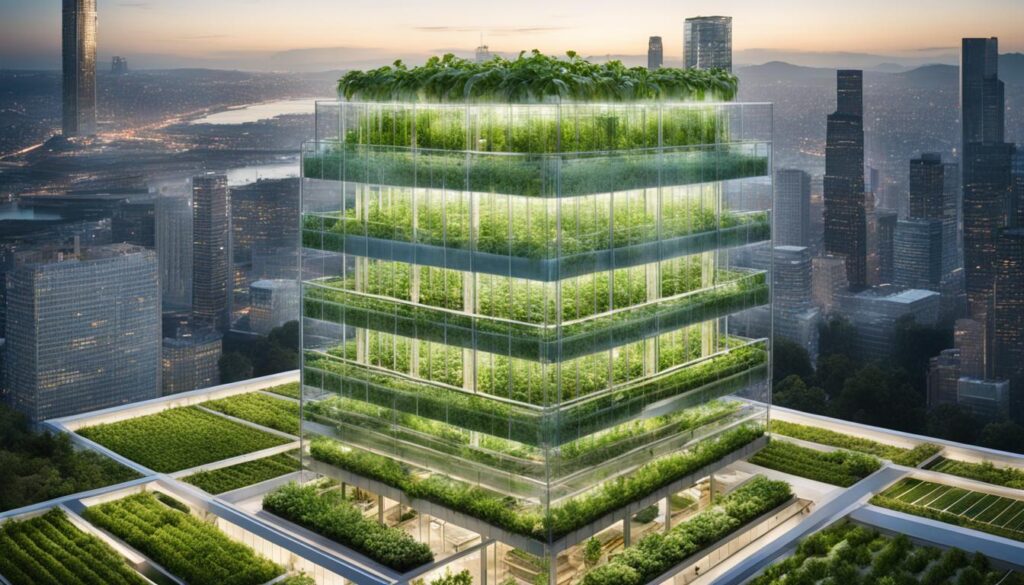With an estimated 9.7 billion people on earth by 2050, food security is a big worry. Vertical farming is seen as a way to help, because it can produce more using less water and grow crops all year in cities. Yet, vertical farming also has some issues we need to look at closely.
Vertical farming grows crops up and down indoors. This new way has many people excited because it can solve old farming problems. It is good for using water better and not hurting the earth as much. But, there are problems we must solve for it to work well.
We will look at the smart side and downsides of vertical farming. We will talk about the money it takes to start and run these farms, the few kinds of crops they can grow, and how much energy they need for lights and climate control. Plus, we will cover the skills and knowledge the people running these farms need. They are important if we want these farms to be everywhere.
Key Takeaways
- Starting a vertical farm is more costly than regular farms. It takes a lot to buy the land, set up the space, and get equipment. Plus, you always have to spend on energy, people working, and other things.
- Only a few types of crops do well in vertical farms because they need to grow fast and make a lot of money. Plants like leafy greens and herbs are most common.
- Vertical farms use a lot of energy. The lights and machines that control the air cost a lot to run. They also might not be good for the environment.
- Running a vertical farm well needs special knowledge in machines, plant care, and fixing things. Finding and keeping people with these skills can be hard.
- Vertical farming is still new, so there is a lot to learn. More research, learning, and working together in the farming community can fix the gaps in what we know.
Introduction
Modern indoor farming started in the late 20th century. Since then, the idea of vertical farming has been talked about a lot. We’ll look at vertical farming in this article. It’s a new way of growing food that helps with big issues like food security and climate change.
What is Vertical Farming?
Vertical farming grows crops in layers, one on top of the other. It happens inside, in places like buildings or shipping containers. This way of farming uses special lights, controls the air and water, and has robots to help. These make sure the plants grow really well and use space better.
Advantages of Vertical Farming
One big plus of vertical farming is it saves on water. It grows food in a way that is good for the planet and the people who eat it. Also, because it’s all inside, you can grow food all year. This is great news for areas that need more fresh food, like cities. It helps with making cities better and feeding everyone, especially when there are more people living in them.
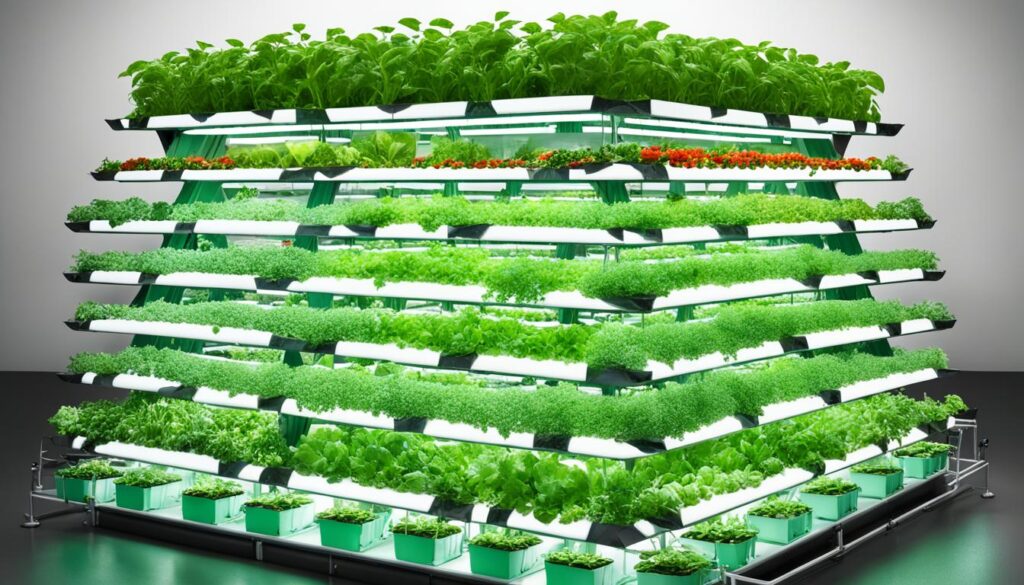
High Initial Costs
Starting a vertical farm needs a lot of money. Everything from picking the right place to the best crops is pricey. The cost to begin can be a big problem, especially in urban areas where land prices are high.
Land and Facility Costs
Vertical farms need special places for farming inside. People use shipping containers and abandoned buildings for this. They work good because they keep the right temperature. But, getting and fixing these places can be very expensive. This makes it hard for vertical farms to make money at first.
Equipment Costs
Vertical farming also needs special equipment. This includes things like grow lights and water systems. The cost of this equipment is a big part of getting started. It can be tough for new vertical farms to get this equipment.
| Cost Category | Range |
|---|---|
| Land and Facility Costs | $500,000 – $10 million |
| Equipment Costs | $200,000 – $5 million |
| Startup Costs | $1 million – $25 million |
Getting into vertical farming needs a huge first cost. This is tough for new farmers. But, there are new ways to get help with paying for this.
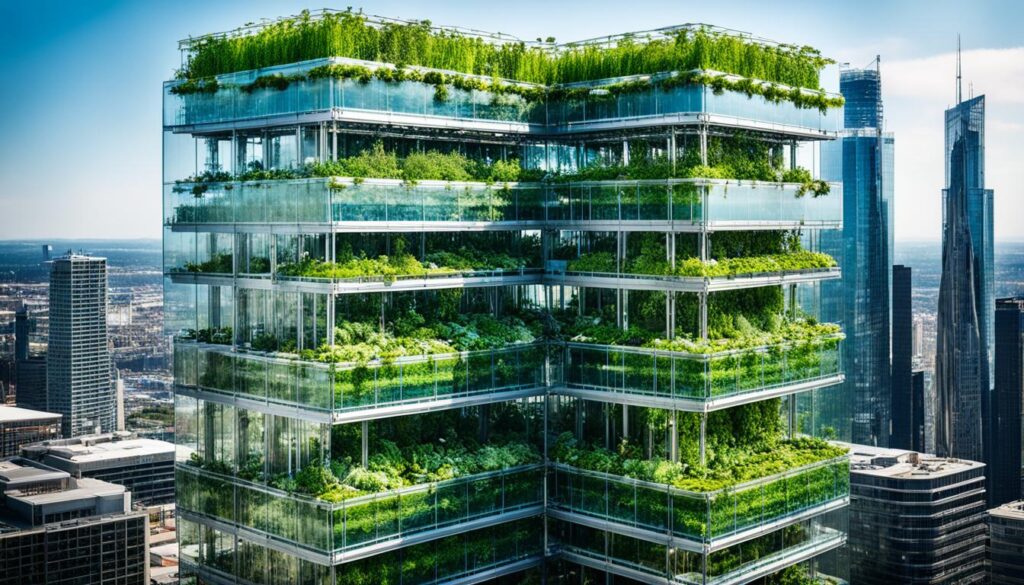
High Operational Costs
Vertical farming has many good sides. But, it costs a lot to run. This can lower its overall money-making ability. High costs are because of
energy use, needing a lot of people, and other changing costs
involved in operating such a farm.
Energy Consumption
Having a vertical farm takes much energy. For example, the need for energy and cost for lights uses up 40-50% of all costs. And, lighting itself makes up 25-30% of what it costs to run the farm.
These farms use special LED lights to grow plants inside. This helps in keeping the plants healthy in a controlled space.
Labor Costs
Running a vertical farm also means spending a lot on workers. They are needed to handle all the different jobs. This includes people like plant experts, engineers, and computer experts.
All these different workers make the farm run well. They help with growing and taking care of plants.
Other Operational Costs
There are more costs besides energy and workers’ pay. You have to buy things like plant food, soil, and seeds. These things can make the farm’s budget bigger.
To deal with these big costs, farmers need to find ways to save. They should also use new technology to make their farms more efficient.
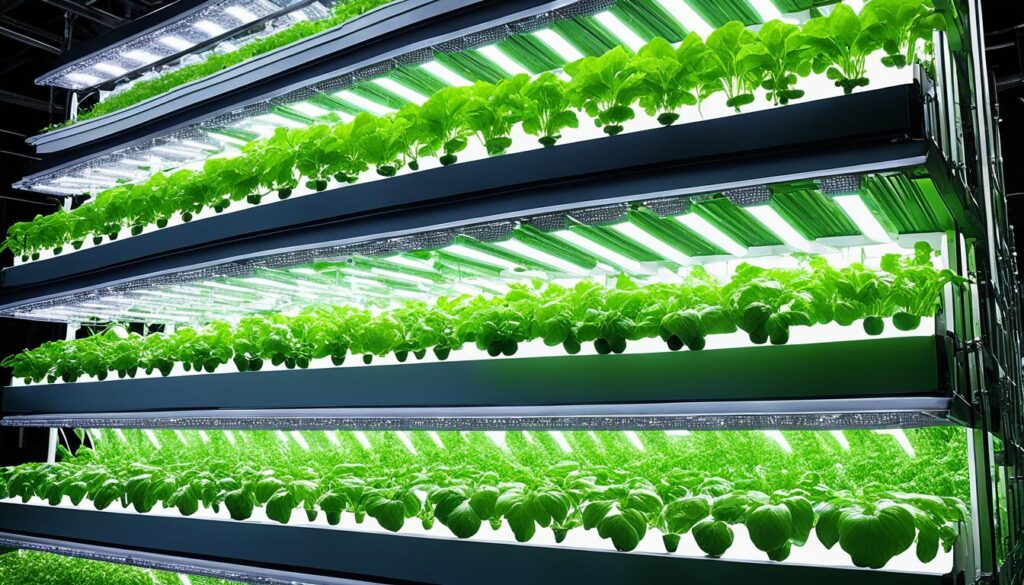
Disadvantages of Vertical Farming
Vertical farming has many good points. Yet, it has its own bad parts to think about. Two main issues are the
Limited Crop Variety
and
Low Caloric Density
of the crops that are good for vertical farming.
Vertical farms can grow many kinds of plants. But, not all plants can be grown and sold at a profit. Leafy greens and herbs are the favorites. They are quick to grow, fetch a good price, but they don’t last long. Crops like strawberries, tomatoes, and grains are harder to grow. They don’t make as much money for the farmers.
Also, most of the food from vertical farms is low in calories. Leafy greens and herbs don’t provide many calories. This is not great for solving big food problems. We need food that is rich in calories and nutrients.
While there are new technologies that might help in the future, these are the main issues now. Limited types of crops and low-calorie food are key problems. We need to fix these to make vertical farming really work for everyone.
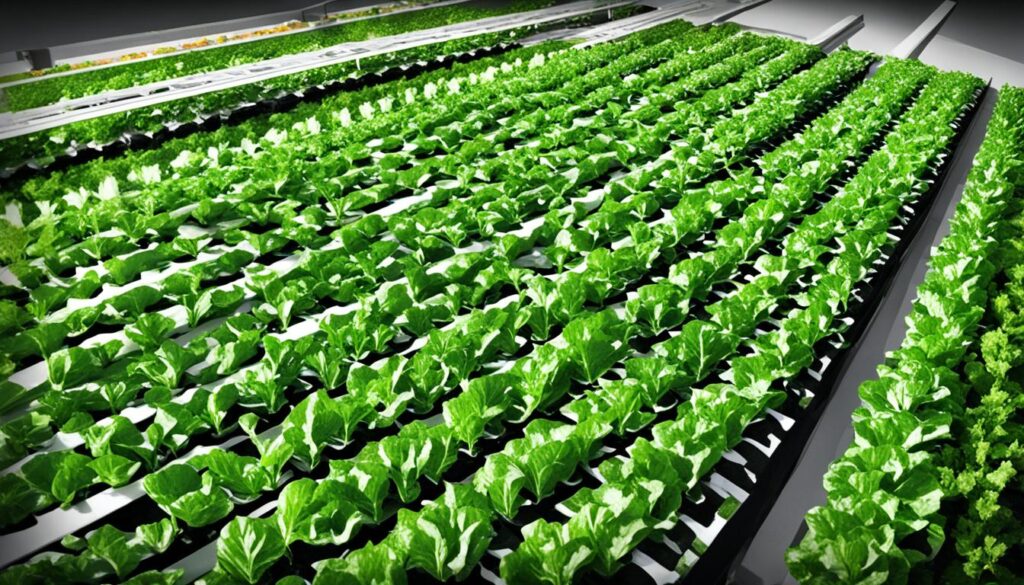
Excessive Energy Demand
Vertical farms use a lot of energy. They need artificial lighting, climate control, and advanced HVAC systems. This can be up to half the cost of running the farm.
Artificial Lighting Requirements
In vertical farming, crops grow under energy-efficient LED lighting. These lights may be on for 12 to 20 hours. This is key for carbon footprint and energy use.
Renewable Energy Solutions
Leaders in farming are looking into wind power and solar power to lower energy use. This can make farming more sustainable. New HVAC systems and energy-efficient tech also help save energy.

Need for Specialized Skills
Running a vertical farm is tough. It needs both tech and plant know-how. Few around the world have these skills.
It’s all about the team. Automation engineers, software engineers, horticulturists, biologists, and maintenance engineers work together. They make sure the farm grows right. Their skills make the farm work well.
Automation and Software Engineering
Vertical farming uses a lot of tech and smart software. Automation engineers create the systems that control the farm. These include lights, temperature, and more. Software engineers build the programs to help the farm run well. They use AI and machine learning to improve things.
Horticulture and Biology
Horticulturists and biologists are key. They pick the best plants and care for them. Their knowledge makes sure the farm’s plants are healthy. They also work to make the crops better.
Maintenance Engineering
Keeping the farm’s equipment working is a big job. Maintenance engineers fix and upgrade things. They know a lot about the machines and technology. They help keep the farm up to date.
Vertical farming skills are in high demand. Companies are teaming up with schools and universities to train new workers. This way, the farming industry keeps getting better.
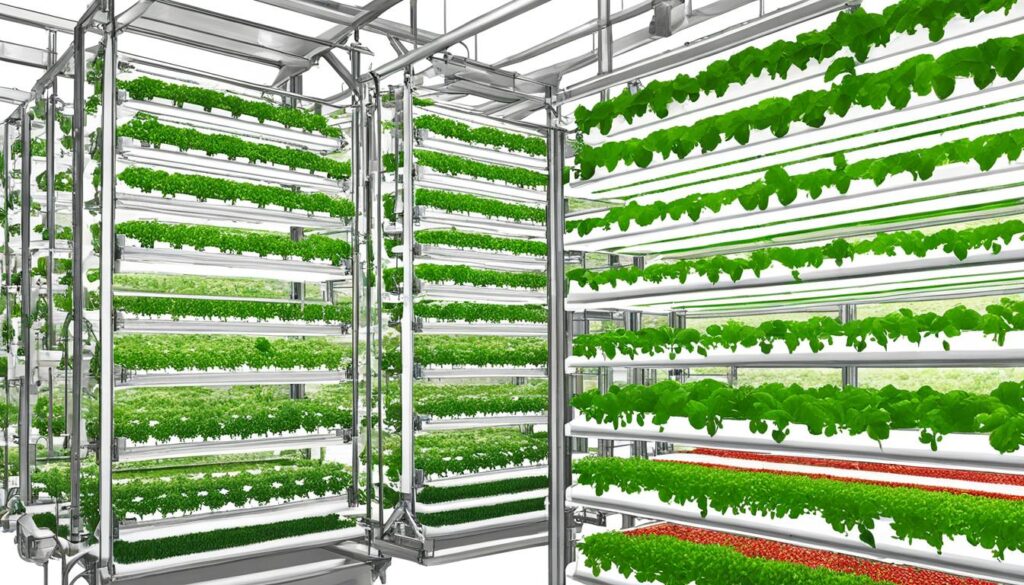
Limited Knowledge and Research
The idea of vertical farming started in 1999. Since then, it has grown big all around the world. But, many people still don’t understand how indoor farming works compared to outdoor farming.
Knowledge Gap in Indoor Farming
People who study plants and those who design farming machines are trying hard. They want to know how to make things grow indoors with the right air and light. They need to know more about how to grow plants exactly, how to use new science to help, and what good food looks like. This is hard work, but they’re trying to make it work all year long.
Initiatives to Bridge the Gap
Upstart University is helping by offering classes online. They teach people who want to be future farmers about growing plants without soil, using fish to help, and the latest farming tools. The goal is to get more people ready to make indoor farming better.
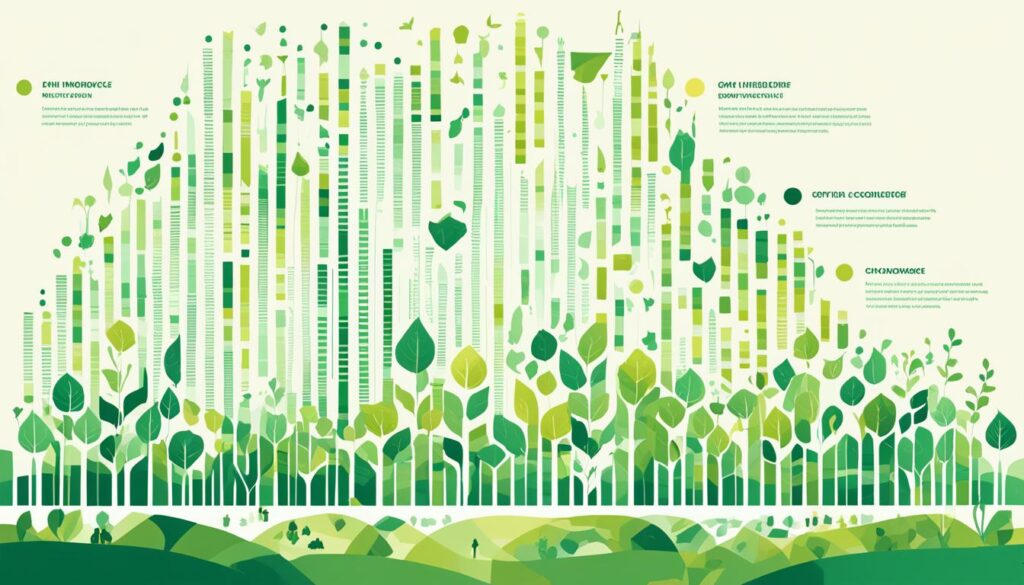
Conclusion
Vertical farming helps us deal with big world problems like more people, more cities, and the changing climate. It’s growing fast because of better lights, air control, and machines. These advancements make food more sustainable and better for our planet.
This type of farming uses space well, saves water, and grows food all year. But starting can be expensive, it uses a lot of energy, and you can’t grow every type of food. The need for skilled workers is also a challenge. Despite these issues, experts and leaders are finding solutions. They want to make sure vertical farming is a stronger, greener choice for the future.
The future looks bright for vertical farming. More people are living in cities, which will need more food. Thanks to new tech, farming without fields will get cheaper. This means both small and big farms can make food in better ways. Skill development and sharing farming knowledge will also help the industry grow.

